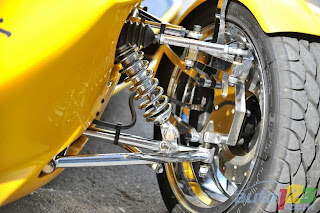“What is that thing?!” is the most common question you’ll get when tearing around town in a T-Rex 1400R. And after spending a solid week in and out of this $52,000 3-wheeled crossbreed, I’ve come to the conclusion that it is one part car, one part bike, and the answer to your innermost desire for something wildly unconventional.
You might recall the early days of the T-Rex’s existence-perhaps during its few rap-music video appearances in the 1990s—but since Canadian company Campagna Motors acquired the rights to manufacture it as of September 2008, the T-Rex 1400R looks to hit the street scene again with new improvements and intentions.
The 1400 in the T-Rex name, as one would correctly assume, follows the usual motorcycle nomenclature and is indicative of the engine’s displacement in cubic centimeters. The 1.4-liter inline-4 is borrowed from a Kawasaki ZX-14 Supersport bike, as is much of the hardware including its sequential gearbox, gauges and ancillary controls. Don’t let the diminutive size of this naturally aspirated engine fool you, it cranks out an impressive 197 bhp and 114 lb.-ft. of torque as it screams towards an exospheric redline at 11,500 rpm. The engine’s peak torque occurs at 7500 rpm, which delivers a mid-range power punch much like a 2-stroke, but with far greater driveability. The engine is mounted mid-ship between the main body and rear swing arm, favoring weight balance to the front by 6 percent. The purpose built tube-chassis is covered with a fiberglass body that incorporates a roof with an integrated ram-air intake scoop, side ducting to a central radiator and, of course, the T-Rex’s somewhat prehistoric-era visage.
Ingress/egress is not for the impatient or non-athletic, meaning if you have issues getting into a Lotus Elise, you probably won’t be too fond of this thing either. It’s best to remove the steering wheel first (as in an open-wheel car) which releases from its hub via an NRG twist-lock connector. The seats and pedal cluster have slide bars with lock pins that make them manually adjustable, but will require you to hop in and out a few times to get them exactly right.
Once you’re situated and strapped in with the traditional 3-point belt, the engine is brought to life as it would be in a motorcycle-turn the key, flip the ignition switch and push the starter. Start up is surprisingly mellow and neighborhood friendly, as the dual-can exhausts actually do what they’re supposed to. The driving controls are primarily car, meaning there’s three pedals, a gear shift, a steering wheel linked to a non-assisted rack and pinion and no need for prior motorcycle experience (or a license for that matter) to operate it. Lane-change signals and horn control is retained on the motorcycle stalks while reverse is the only real oddity, handled with a lever beside your left thigh that mechanically switches the direction the gears spin.
On the road, you sit eye-to-bumper with most cars, which is good for stability, but presents a challenge for visibility (a whiptail might make for a nice add-on). At 1130 lb. (fully fueled), the T-Rex has a power-to-weight ratio that provides a rate of acceleration that virtually stops time. This is your single greatest defense against becoming a sitting duck in a sea of treacherous traffic that will either be oblivious to your existence or gravitate uncomfortably close for a better look. The tiny motorcycle side mirrors provide some form of rear view while the roof-mounted mirror provides an excellent view of the ram--air intake tubes. This makes lane changes a precarious affair, and those last-minutes checks for Johnny Law on the open highway are somewhat difficult. When not subjected to the crowded highways, the T-Rex is about as close as you can come to the therapeutic, open-air experience of a motorcycle-less any talent required for balancing on two wheels.
Source: http://www.roadandtrack.com
Source: http://www.roadandtrack.com
















No comments:
Post a Comment